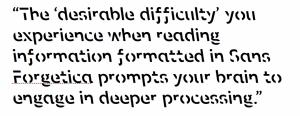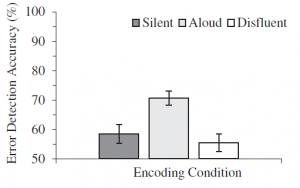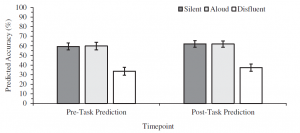Via het blog van The Learning Scientists kwam ik terecht bij een recent onderzoek (Cushing & Bodner, 2022) waaruit blijkt dat je fouten in een tekst beter oppikt wanneer je de tekst hardop leest dan wanneer je dat in stilte doet of wanneer je de tekst in een speciaal lettertype, zoals Sans Forgetica, zet om te herlezen.
Dit lettertype, een zogenoemd ‘disfluent font’ (figuur 1), werd speciaal ontworpen om ervoor te zorgen dat je de tekst die je leest beter onthoudt. Het font is moeilijker leesbaar waardoor je meer moeite moet doen om de tekst te lezen waardoor je de inhoud mogelijk beter onthoudt. Dit zou je als een desirable difficulty (Robert Bjork) kunnen omschrijven.

figuur 1 – font Sans Forgetica
Uit een meta-analyse (Xie, Zhou & Liu, 2018) blijkt dit soort lettertype niet meteen tot betere leerprestaties te leiden. Maar misschien zorgt het er wel voor dat je de tekst trager leest en je daardoor beter de fouten in een schrijfopdracht opmerkt?
Cushing & Bodner lieten teksten op 3 manieren herlezen: in stilte, hardop of in een ‘disfluent’ lettertype. Elke tekst bevatte een tot vijf fouten, dus de proefpersonen konden verder lezen zonder al te veel fouten. Uit de resultaten bleek dat luidop herlezen tot veel betere resultaten leidde dan de andere interventies (figuur 2).

De onderzoekers vroegen de proefpersonen vooraf en na afloop welke aanpak volgens hen de beste was. Vooraf waren de proefpersonen ervan overtuigd dat in stilte en luidop herlezen tot even goede resultaten zou leiden. Opmerkelijk was dat ze hier ook na afloop nog steeds van overtuigd waren, ook al hadden ze net de fouten beter opgemerkt door de tekst hardop te herlezen (figuur 3).

Dit toont aan dat bepaalde overtuiging soms moeilijk te veranderen zijn, waardoor we soms kiezen voor een foute strategie. Zo gebruiken studenten vaak spontaan weinig effectieve studeerstrategieën zoals herlezen of gegroepeerd oefenen terwijl jezelf toetsen tijdens het leren (retrieval practice) of afwisselend oefenen (interleaving) net tot betere resultaten leidt. Fouten merk je beter op wanneer je een tekst luidop herleest maar ons buikgevoel lijkt dit niet altijd voldoende te beamen. Spoor je leerlingen of studenten dus expliciet aan om dit te doen.
Referenties
(1) Cushing, C., & Bodner, G. E. (2022). Reading aloud improves proofreading (but using Sans Forgetica font does not). Journal of Applied Research in Memory and Cognition, 11(3), 427-436. https://doi.org/10.1037/mac0000011
Abstract
Proofreading is an important cognitive skill, yet methods for enhancing error detection have received little research attention. We report two experiments comparing the efficacy of proofreading aloud (i.e., “production”)—a common proofreading tip—versus in a disfluent font (Sans Forgetica) purported to introduce a desirable difficulty. Participants read eight short texts silently, eight aloud, and eight in the disfluent font—and recorded the noncontextual errors (i.e., typos) and contextual errors (i.e., grammar, word choice) that they detected. Relative to silent reading, proofreading aloud improved detection of both types of errors, whereas the disfluent font impaired detection of noncontextual errors and did not aid detection of contextual errors. Metacognitively, participants did not expect the benefit of reading aloud, whereas they expected the disfluent font to impair proofreading. Proofreading aloud works, and invites further research on how it works, whereas there was no indication that proofreading in a disfluent font is useful. (PsycInfo Database Record (c) 2022 APA, all rights reserved)
(2) Xie, H., Zhou, Z., & Liu, Q. (2018). Null effects of perceptual disfluency on learning outcomes in a text-based educational context: A meta-analysis. Educational Psychology Review, 30(3), 745–771. https://doi.org/10.1007/s10648-018-9442-x
Abstract
Recent research in a text-based educational context has demonstrated a seemingly paradoxical disfluency effect in reading, namely that learning with hard-to-read (disfluent) materials helps learners recall more details than learning with easy-to-read (fluent) materials. Many follow-up studies using a variety of participants, learning materials, and experimental designs have been conducted to verify the effects of disfluency manipulation on recall, transfer, judgments of learning, and learning time. However, a number of them have failed to replicate this effect and the mixed findings bring into question the generality of the disfluency effect with respect to learning. In this meta-analysis, we tested the overall effect of perceptual disfluency on learning with texts, as well as moderators of this effect, based on 25 empirical articles involving 3135 participants. Results showed that overall, there was no effect of perceptual disfluency on recall (d = − 0.01) or transfer (d = 0.03), but perceptual disfluency did reduce participants’ judgments of learning (d = − 0.43) and increase learning time (d = 0.52). Tests of moderation focused on the most commonly studied dependent measure, namely recall. There was no evidence that characteristics of the participants, learning material, or experimental design moderated the effect of perceptual disfluency on recall. In general, though perceptual disfluency can be used as an effective metacognitive cue to reduce judgments of learning and increase learning time, there is not enough evidence to show that it either stimulates analytic processing or increases extraneous cognitive load.

